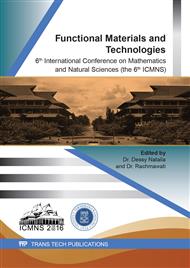[1]
Lanlan Yu, Yexuan Mao, and Lingbo Qu, Simple Voltammetric Determination of Rhodamine B by Using the Glassy Carbon Electrode in Fruit Juice and Preserved Fruit, Food Anal. Methods 6 (2013) 1665-1670.
DOI: 10.1007/s12161-013-9580-1
Google Scholar
[2]
Xiaomeng Su, Xiaoyan Li, Junjie Li, Min Liu, Fuhou Lei, Xuecai Tan, Pengfei Li, and Weiqiang Lu, Synthesis and Characterization of Core–Shell Magnetic Molecularly Imprinted Polymers for Solid-Phase Extraction and Determination of Rhodamine B in Food, Food Chem. 171 (2015) 292-297.
DOI: 10.1016/j.foodchem.2014.09.024
Google Scholar
[3]
Ping Qi, Zhihao Lin, Jiaxu Li, ChengLong Wang, WeiWei Meng, Hong Hong, and Xuewu Zhang, Development of A Rapid, Simple and Sensitive HPLC-FLD Method for Determination of Rhodamine B in Chili-Containing Products, Food Chem., 164 (2014) 98-103.
DOI: 10.1016/j.foodchem.2014.05.036
Google Scholar
[4]
Chiye Tatebe, Xining Zhong, Takashi Ohtsuki, Hiroki Kubota, Kyoko Sato, and Hiroshi Akiyama, A Simple and Rapid Chromatographic Method to Determine Unauthorized Basic Colorants (Rhodamine B, Auramine O, and Pararosaniline) in Processed Foods, Food Science & Nutrition 2 (2014) 547-556.
DOI: 10.1002/fsn3.127
Google Scholar
[5]
N. Pourreza, S. Rastegarzadeh, and A. Larki, Micelle-Mediated Cloud Point Extraction and Spectrophotometric Determination of Rhodamine B Using Triton X-100, Talanta 77 (2008) 733-736.
DOI: 10.1016/j.talanta.2008.07.031
Google Scholar
[6]
Wilhelm P. and Stephan D., Photodegradation of Rhodamine B in Aqueous Solution Via Sio2@Tio2 Nano-Spheres, J. Photochem. Photobiol., A. 185 (2007) 19-25.
DOI: 10.1016/j.jphotochem.2006.05.003
Google Scholar
[7]
R.L. Gresshma and M.P. Reject Paul, Qualitative and Quantitative Detection of Rhodamine B Extracted from Different Food Items using Visible Spectrophotometry, Malaysian Journal of Forensic Sciences, 3 (2012) 36-40.
Google Scholar
[8]
Ying Zhang, Liqiang Luo, Yaping Ding, Xiao Liu, and Zheyuan Qian, A Highly Sensitive Method for Determination of Paracetamol by Adsorptive Stripping Voltammetry Using A Carbon Paste Electrode Modified with Nanogold and Glutamic Acid, Microchim. Acta 171 (2010) 133-138.
DOI: 10.1007/s00604-010-0422-1
Google Scholar
[9]
Yuanzhen Zhou, Maofang He, Sheying Dong, and Jianbin Zheng, A Biosensor for Sensitive and Selective Determination of Dopamine Based on Poly(methyl red) Film Modified Electrode, J. Electrochem. Soc., 159 (2012) F17-F22.
DOI: 10.1149/2.042202jes
Google Scholar
[10]
Ke-Jing Huang, Chun-Xuan Xu, jun-Yong Sun, Wan-Zhen Xie, and Liu Peng, Electrochemical Oxidation of Tryptophan and Its Analysis in Pharmaceutical Formulations at a Poly(Methyl Red) Film-Modified Electrode, Anal. Lett., 43 (2009) 176-185.
DOI: 10.1080/00032710903276604
Google Scholar
[11]
Madiha Bougrini, Anca Florea, Cecilia Cristea, Robert Sandulescu, Francis Vocanson, Abdelhamid Errachid, Benachir Bouchikhi, Nezha El Bari, and Nicole Jaffrezic-Renault, Development of A Novel Sensitive Molecularly Imprinted Polymer Sensor Based on Electropolymerization of A Microporous-Metalorganic Framework for Tetracycline Detection in Honey, Food Control 59 (2016) 424-429.
DOI: 10.1016/j.foodcont.2015.06.002
Google Scholar
[12]
Diego L. Franco, André S. Afonso, Sabrina N. Vieira, Lucas F. Ferreira, Rafael A. Gonçalves, Ana G. Brito-Madurro, and João Madurro, Electropolymerization of 3-Aminophenol on Carbon Graphite Surface: Electric And Morphologic Properties, Mater. Chem. Phys. 107 (2008) 404-409.
DOI: 10.1016/j.matchemphys.2007.08.006
Google Scholar
[13]
Sezen Kurşun, Aziz Paşahan, Bilge Z. Ekinci, and Ergun Ekinci, Poly (3-aminophenol) Film as a Uric Acid-Selective Electrode, Int. J. Polym. Mater. 60 (2011) 365-373.
DOI: 10.1080/00914037.2010.531807
Google Scholar
[14]
Vinod K. Gupta, Rajeev Jain, Arunima Nayak, Shilpi Agarwal, and Meenakshi Shrivastava, Removal of The Hazardous Dye—Tartrazine by Photodegradation on Titanium Dioxide Surface, Mater. Sci. Eng., C. 31 (2011) 1062-1067.
DOI: 10.1016/j.msec.2011.03.006
Google Scholar
[15]
P. Panneer Selvan, S. Preethi, P. Basakaralingam, N. Thinakaran, A. Sivasamy, and S. Sivanesan, Removal of Rhodamine B from Aqueous Solution by Adsorption onto Sodium Montmorillonite, J. Hazard. Mater.s 155 (2008) 39-44.
DOI: 10.1016/j.jhazmat.2007.11.025
Google Scholar
[16]
Mohammad Ali Karimi, Vida Haji Aghaei, Azizollah Nezhadali, and Narges Ajami, Graphitic Carbon Nitride as a New Sensitive Material for Electrochemical Determination of Trace Amounts of Tartrazine in Food Samples, Food Anal. Methods 11 (2018) 2907-2915.
DOI: 10.1007/s12161-018-1264-4
Google Scholar
[17]
Tony Thomas, Ronald J. Mascarenhas, and B.E. Kumara Swamy, Poly(Rhodamine B) Modified Carbon Paste Electrode For the Selective Detection of Dopamine, J. Mol. Liq. 174 (2012) 70-75.
DOI: 10.1016/j.molliq.2012.07.022
Google Scholar


